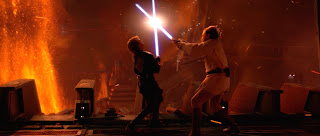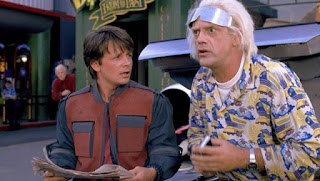Top 8 Lightsaber Battles
(WARNING: This article contains Last Jedi spoilers!)
Ah,
the lightsaber battle. A quintessential part of any Star Wars experience, there’s little better than seeing Jedi and
Sith whip out their signature blades and begin a legendary duel. What’s even
better is that with the advent of the Prequels and Sequels, lightsaber battles
have become more than simple swordfights. Now they can be spectacles that show
off tons of awesome choreography, as well as more subtle, being used to further
character development.
So
I’ll be ranking my favourites today! A few rules before we start: I’ll be doing
the movies only today, so no Clone Wars or
Rebels battles for now. I’m also only
allowed to pick one battle per movie, and at least two people in the scene must
be wielding a lightsaber, and they must be fighting against each other. So no Rogue One Vader hallway scene, no Attack of the Clones coliseum, no Last Jedi throne room, and so on.
With
that said, let’s begin!
8. Obi-Wan vs. Darth Vader (A New Hope)
Despite
being the first example of a lightsaber battle in the franchise’s history,
Obi-Wan’s climactic showdown against his former student aboard the Death
Star…hasn’t aged spectacularly.
While
it’s nowhere near as slow as some fans joke, when compared to literally any
other battle from the movies it does look pretty laughably clunky and stagnant.
Obi-Wan and Vader knock their lightsabers together a few times and then
sometimes they turn around and move backwards a bit. Then one of them delivers
some dialogue, and then they do it again.
I
especially enjoy this weird lunging move Vader tries at about the halfway mark.
He looks like he’s trying to poke Obi-Wan’s belly more than he’s trying to
strike him down.
A
fan is actually trying to modernize this fight a bit with what he calls “Scene
38 Reimagined”, a CGI remake of the battle more in line with the lightsaber
battles of the modern movies. While it isn’t finished yet, check out this
preview and tell me it doesn’t look awesome.
7. Anakin, Obi-Wan and Yoda vs. Count Dooku
(Attack of the Clones)
This
one is easily the most controversial lightsaber battle in the saga, and for a
few good reasons. The amazingness that is the Prequel Dialogue is out in full force
here (“You’re gonna pay for all the Jedi that you killed today, Dooku!”), Count
Dooku is a pretty boring bad guy no matter how cool Christopher Lee tries to
make him, and yeah, I can get why some fans see Yoda with a lightsaber as a
betrayal of his character.
But
despite all that, this is still a pretty neat fight as far as I’m concerned. I
really like the short part where Anakin shuts down the electricity and the
entire fight is illuminated just by their lightsabers. It’s a really cool
effect you can’t see anywhere else in the movies.
And,
I’ve gotta admit, I think lightsaber Yoda is awesome. Yes, it’s silly, but
c’mon, so is everything else in the Prequel Trilogy. Seeing him jump around and
spin while fighting Dooku is just hilarious, and I love it no matter what.
While
this fight lacks the style and substance of some of the ones further up the
list, it’s still entertaining, and I’ve gotta give it that.
6. Luke vs. Kylo Ren (The Last Jedi)
Does
this one even count? I’m not sure, but this is my list and this is also the
closest thing Last Jedi has to a one-on-one lightsaber battle, so here it is closer to the bottom.
This
battle is easily the shortest one in any of the movies, and the only one where
the lightsabers never clash (for obvious reasons to those who know how the
scene ends). The scene is clearly far more concerned with being more about
Luke’s first meeting with Kylo since what happened at his temple instead of
being a big flashy showdown between the two, and it succeeds in that regard.
The
fight definitely holds lots of inspiration from Lucas’s own inspiration for Star Wars in Japanese samurai movies. A
lot more time is spent just seeing Luke and Kylo stand off against each other,
studying the other and trying to predict the move they’re going to make. Luke
spends the whole fight feigning being on the defensive, which gives us a fun
show of how he’s improved in combat since Return
of the Jedi. Definitely a simpler fight with some very unusual circumstances,
but a good one as well.
5. Luke vs. Darth Vader - Round 2 (Return of
the Jedi)
Another
fight without much fight, the climactic lightsaber battle of the Original
Trilogy is much more concerned with Luke’s internal debate of Light Side vs. Dark
Side, as well as his mission to redeem his father.
One
thing I really like about this fight is all the things we see for the first
time here when the lightsabers are turned on. This is the first time we see
someone try the good ol’ boomerang lightsaber move when Vader knocks down the
catwalk Luke is standing on. This is also the first lightsaber battle where we
see someone give into their anger entirely, as we see with Luke when Vader
threatens Leia.
I
especially love how Luke finishes the fight once he finally gives in to his
anger. Vader, who basically embarrassed him on Cloud City in the last movie, is
brought to his knees in a matter of minutes. It’s a true perfect bookend to the
arc Luke goes on in the movie, and is made even better by his and Vader’s
decisions in the following moments.
4. Rey and Finn vs. Kylo Ren (The Force
Awakens)
When
it comes to lightsaber battles, Revenge
of the Sith was a hard act to follow. While the epic duel between Obi-Wan
and Anakin was heavy on the CGI, it also demonstrated some amazing
choreography, truly feeling like the lightsaber battle to close out Star Wars once and for all.
So
when The Force Awakens was announced,
people were unsure if the big lightsaber battle to end off the movie would be
able to match up with the best ones from the other two trilogies. While it
isn’t my favourite battle of them all, it’s definitely up there.
One
thing I really like about this fight is how it bookends Finn’s character arc in
the movie perfectly. He spends the whole movie up to that point running from
everything, particularly the First Order. Then, when confronted with Kylo Ren,
he runs towards the danger to protect his friend. It’s the perfect way to
finish off his story.
Of
course the actual battle itself between Rey and Kylo is awesome, and I
especially like the symbolism with the ravine that opens up between them at the
end. With any luck we’ll get a rematch between them in Episode IX, but it’s
gonna be hard to top their first bout.
3. Obi-Wan vs. Anakin (Revenge of the Sith)
And here’s the king of flash itself: the big
climactic showdown between Obi-Wan and Anakin. I remember that when Revenge of the Sith was being promoted,
despite being the climax of the movie the duel was the thing that was being
shown off the most.
While
I know some might dislike this duel because of how CGI’d everything is, but
seriously? The whole thing is so awesome that some of the worse looking effects
are easily forgiven. The choreography is beautifully done. The speed of the
duel itself is to this day unmatched by any other live-action Star Wars product. The volcanic setting
of Mustafar is awesome. And, perhaps best of all, this scene has some of the
best acting in the entire trilogy courtesy of both Hayden Christensen and Ewan
McGregor.
The
ending to the fight is one of the best scenes in all of Star Wars as far as I’m concerned. Obi-Wan thinking he’s killed his
former student while Anakin desperately grasps for a way to escape the lava is
beautifully shot, beautifully acted, and, in a surprising twist for a Prequel,
very well-written. McGregor sells this scene like no other in the trilogy, and
for good reason. It was originally planned to be the final battle of all of Star Wars, and it lived up to
expectations.
2. Luke vs. Darth Vader - Round 1 (Empire
Strikes Back)
Perhaps
the most iconic battle in Star Wars,
the duel between Luke and Vader on Cloud City has a lot going for it: the
lighting is awesome, putting the dark shadows cast by the carbon-freezing
chamber to good use. The choreography is great, especially in the second half
when Vader starts putting Luke to shame, and it has perhaps the best ending to
any fight in any movie ever.
A
lot of what makes this fight great is how it subverts expectations. As Luke
leaves Dagobah both Yoda and Obi-Wan warn him that Vader’s gonna royally
embarrass him. Then he arrives at Cloud City and things get even more
intimidating as he sees his friends dragged away and Leia warns him of the
trap. Then he finally arrives at the chamber and Vader begins taunting him,
telling him that he still isn’t a Jedi. They spar for a bit, and then…Luke
knocks him off the platform. Uh…okay. That was easy.
But
things get better in the second half of the battle. Just when it looks like
Luke is going to make an escape, Vader returns, and without saying a word he
does exactly what Yoda predicted he’d do. Without barely moving a muscle he’s
able to launch Luke out into the catwalk. Then Vader goes on the aggressive,
lunging out at Luke from the shadows and chasing him down until he has him
completely cornered.
And
then…the twist. We all know what it is, but the big surprise suddenly paints
the entire story up to that point in a completely different light. This battle
alone changed the course of not just Star
Wars, but cinema itself with just four simple words: “I am your father”.
1. Qui-Gon and Obi-Wan vs. Darth Maul (The
Phantom Menace)
The
battle from Force Awakens might’ve
had the most character development. The battle from Revenge of the Sith might’ve been the flashiest. The battle from Empire Strikes Back might’ve had the
biggest surprise.
But
for my money, there is no lightsaber battle in all of Star Wars than the Duel of the Fates in the climax of The Phantom Menace.
Yeah,
the movie surrounding it might be bad, but this battle is like an oasis in the
centre of a harsh and unforgiving desert environment. The climactic showdown
between Qui-Gon and Obi-Wan against the mysterious Sith lord Darth Maul is
awesome from the first few seconds. The doors open, revealing Maul awaiting
inside. Qui-Gon sends Padme and the rest to find another way out of the palace.
The epic John Williams piece kicks in. Maul ignites his double-bladed
lightsaber. And then the fight’s on.
The
choreography and music alone are enough to put this one at the top for me.
Unlike most if not all the other battles on this list, the Duel of the Fates
plays out with very little dialogue spoken, instead telling its story through
the battle itself. While Phantom Menace is
definitely the most kid-friendly Star
Wars thanks to a certain Gungan, this duel is surprisingly dark. There
isn’t much colour in the scenery. The jokes have stopped. Maul himself is a
really intimidating villain. The music is epic and intense (to date still one
of cinema’s best fight scene songs).
And
the fight itself is awesome. A perfect blend of fast action and slow moments,
all while not saying a word, make up for the perfect ending to an overall
mediocre movie. It’s just awesome overall.





























